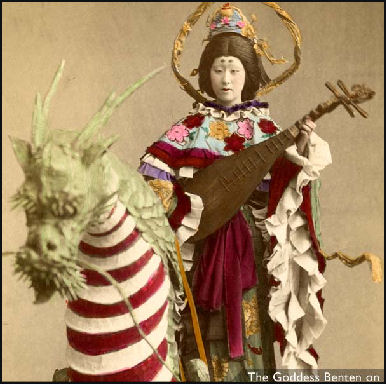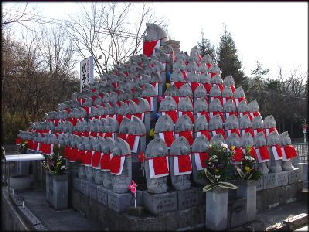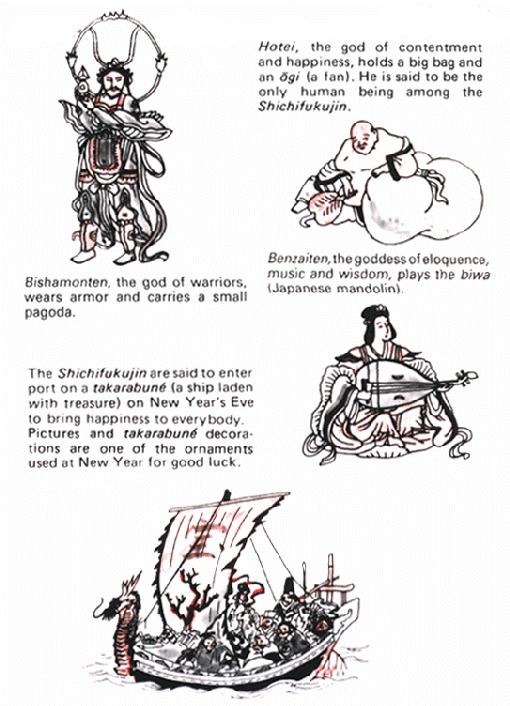BUDDHIST GODS IN JAPAN

a person dressed as Benzaiten There are hundreds of gods in the Buddhist pantheon. Many have been borrowed from the Hindu pantheon to serve a particular purpose in Buddhist cosmology. Some have a humanlike appearance. Others look like monsters. Many have multiple arms and heads and hold various objects and display certain body positions and hand gestures that have symbolic meaning. At temples some serve as guardians and protectors at the entrance gates. Images found in temples vary according to sect and the period in which the temple was constructed. Gods, goddesses, and other celestial being tend to play a bigger role in Mahayana Buddhism than Theravada Buddhism. Mahayana Buddhism introduced a number of female deities.
Bodhisattvas are sort of like the equivalent of Buddhist "saints" and are especially important in Mahayana Buddhism. To Mahayana Buddhists they are "near Buddhas" or “enlightened persons” on the verge of nirvana who purposely stopped short of attaining it, so, like Buddha, they could teach their method to others and help humanity move towards enlightenment. Bodhi means “enlightenment” and sattva means “being.”
Many gods in Japan have both non-Japanese origins. Hotei, one of the seven gods of good luck, is the god of happiness. A common symbol throughout Asia, he is jolly fellow with a big grin, pot belly and a bag sack. His ancestors can be traced back to a real human being, a Chinese monk associated with the Chinese sect that gave birth to Zen Buddhism. Hotei is a bit like a year-round Santa Claus, traveling around the countryside with his sack, giving food and necessities to the poor and needy and giving out presents to those who deserve them. Benzaiten, another one of the seven gods of good luck, is the goddess of art. Wise and skilled in painting and writing, she carries a biwa (mandolin) and is often escorted by a sea snake. Originally a spirit of flowing water with her roots in India, she is the patron saint of musicians and performers. Shrines for her with images of snakes are often set up near ponds.
Bishamon is the god of war and the protector of Buddhism, scared mountains, temples and cities. Usually depicted with a helmet, suit of armor and spear, he was originally a folk god in India and was adopted by Buddhism. He is often found at the north gate or entrance of a building and is skilled at turning away evil spirits that cause poverty and bring bad luck.
Maitreya, also known as the Laughing Buddha, is loving and friendly and based on an early Zen monk who was known for his kindness. He is called the Laughing Buddha because he is most often shown with a round belly sticking out of his robes, and with a big smile on his face. Rubbing his belly is supposed to bring good luck. [Source: Encyclopedia.com]
Links in this Website: RELIGION IN JAPAN Factsanddetails.com/Japan ; SHINTO Factsanddetails.com/Japan ; SHINTO SHRINES, PRIESTS, RITUALS AND CUSTOMS Factsanddetails.com/Japan ; BUDDHISM IN JAPAN Factsanddetails.com/Japan ; BUDDHIST GODS, TEMPLES AND MONKS IN JAPAN Factsanddetails.com/Japan ; ZEN AND OTHER BUDDHIST SECTS IN JAPAN Factsanddetails.com/Japan ; EARLY BUDDHISM IN ASUKA-ERA JAPAN (A.D. 538 to 710) factsanddetails.com; PRINCE SHOTOKU factsanddetails.com; TODAIJI AND THE ESTABLISHMENT OF BUDDHISM IN NARA-ERA JAPAN (A.D. 710-794) factsanddetails.com; NARA-ERA BUDDHIST MONKS, MANDALAS AND RELIGION factsanddetails.com; HEIAN PERIOD BUDDHISM (794-1185) factsanddetails.com; BUDDHISM AND CULTURE IN THE KAMAKURA PERIOD (1185-1333) factsanddetails.com;
Buddhism in Japan Guide to Buddhism in Japan buddhanet.net ; Wikipedia article on Buddhism in Japan Wikipedia Buddhism and Shintoism in Japan A to Z Poto Dictionary onmarkproductions.com Honganji temple Site honganji.net ; History of Japanese Buddhism viewonbuddhism.org ; Buddhism and Prince Shotoku onmarkproductions.com ; Asia Society article on Buddhism in Japan asiasociety.org Japanese-Buddhism.com japanese-buddhism.com; The Zen Site thezensite.com ; Wikipedia article on Zen Buddhism Wikipedia ; Photos Japan-Photo Archive japan-photo.de ; Temples at Japan-Photo Archive japan-photo.de
RECOMMENDED BOOKS:
“Meeting the Buddhas: A Guide to Buddhas, Bodhisattvas, and Tantric Deities”
by Vessantara Amazon.com ;
“The Way of the Bodhisattva: Shambhala” by Padmakara and the Dalai Lama Amazon.com ;
“Bodhisattva of Compassion: The Mystical Tradition of Kuan Yin” by John Blofeld Amazon.com ;
“A Cultural History of Japanese Buddhism” (Wiley-Blackwell Guides to Buddhism) Amazon.com ;
“Early Buddhist Narrative Art: Illustrations of the Life of the Buddha from Central Asia to China, Korea and Japan” by Patricia E. Karetzky Amazon.com;
“Bonds of the Dead: Temples, Burial, and the Transformation of Contemporary Japanese Buddhism” by Mark Michael Rowe Amazon.com ;
“Shugendo: The Way of the Mountain Monks”
by Shokai Koshikidake, Martin Faulks , et al. Amazon.com ;
“Shugendo: Essays on the Structure of Japanese Folk Religion”(Michigan Monograph Series in Japanese Studies) by Hitoshi Miyake and H. Earhart
Amazon.com
Kannon
Important gods and Bodhisattvas in Japan include Kannon, the 1,000-armed, 11-faced goddess of mercy; Jizo (often portrayed with children in his arms), a Bodhisattva who helps children and travelers; Fudo Myoo, a protector against danger and king of wisdom; Yakushi (Bhaisajaguru), the healer of the mind and body; and Amida (literally meaning “infinite light” or “infinite life”), the Buddha of the Western Paradise.
Bato Kannon, Horsehead Kannon, is a manifestation of Kannon often depicted in small stone statues of Kannon with a horse popping out of her hair or headdress. She specializes in caring for the souls of animals and other nonhuman creatures. The god of thunder is portrayed as a snake.
The worship of Kannon flourished during the Nara Period (710-784) and Heian period (794-1192) “ when a great number of temples devoted to Kannon were built in part because of the belief that constructing giant temples helped people enter heaven. Kannon worship is believed to have been imported from China or Korea in the late 6th century in the Asuka Period (538-710).
Tsuka Mounds and Horsehead Kannon

Jizo statues Kevin Short wrote in the Daily Yomiuri: The countryside landscape is dotted with tiny mounds, called tsuka, topped by stone statues or commemorative slabs. Each of these is backed by at least one to several trees. Each site is related to some local story or legend. One very famous mound, protected by cryptomerias, evergreen oaks and Japanese holly-olives, contains several small stone statues depicting Buddhas that have horsehead motifs carved into their headdress. This particular deity is Bato Kannon, or "Horsehead Kannon," and as might be expected, is almost always associated with horses. [Source: Kevin Short, Daily Yomiuri, February 16, 2011]
In the past, horses were widely employed in farmwork, and also for transporting goods and people along the many historic post roads. Bato Kannon statues were commissioned to pray for the health of these valuable animals, and also in repose of their spirits.
Typical trees chosen for commemorative mounds include flowering cherries for their beauty, and hackberries for their excellent shade. Various evergreen oaks are also widely used. Once in a while I find a mound topped by a rare species of native holly. Called inu-tsuge in Japanese, this is an evergreen shrub characterized by very tiny leaves and dark blue-gray fruits.
Most local shrines are situated at the edge of rises overlooking the villages. Commemorative mounds, on the other hand, may be located anywhere. There is a tendency to find them at crossroads or boundaries, but once in a while they can also be seen sticking up among flat open stretches of hatake vegetable fields.
Jizo
Jizo is a patron for travelers and children. He helps children build walls in the underworld and is associated in Japan with helping aborted fetuses and children who died young. According to tradition, Jizo was an Indian monk who became a Bodhisattva. In India he was known by a different name. There is no evidence that he ever had a large following there. In China he gained a reputation for being compassionate and helping people to avoid reincarnation as terrible beasts.
Jizo didn’t develop a large following until he arrived in Japan. His association with rescuing people from unfortunate births was focused on children who died in the hope that they would have good afterlives. Jizo developed a particularly large following among women, who placed statues of him along roadsides and in Buddhist temples. Over time statues of Jizo changed from large ones of a dignified man to small ones of childlike man with a bald head. When abortions became commonplace in Japan places on hillsides were set aside for thousands of jizo statues.
Jizo statues for children usually wear red bid and are decorated with clothing and items such as toys associated with children. Often small piles of stones can be found near the figures. Jizo statues comes in several variations, distinguished by the objects they hold in their hands under the bibs. Jizo also appears in a variety of avatars, including one in which he is a fierce victory god for warriors riding on a horse.
Jizo statues are often found in groups of six, each with their hands in a different mudra (position) and each linked to relieving the pain of residents of the six realms of Buddhist cosmology: 1) one holds his hands in a praying position next to his chest and is associated with the Amida Buddha and the realm of humans: 2) one holds a sacred jewel and holds his hand in the no fear mudra and is associated with deva living on Mt. Sumisen; 3) one holds a set of Buddhist rosary beads and is associated with the realm of the non-human creatures; 4) one holds a sacred jewel and a pilgrims staff and is associated with Ashura, the realm of the deities; 5) one holds an incense banner and is associated with hell; and 6) the last one holds an incense censer and is associated with the realm of the hungry spirits. The six statues are grouped to together because the people who placed them there may not know where their deceased loves ones are and thus say prayers to the entire universe and all realms to reach them.
Japan’s Seven Gods of Good Luck
“Shickifuku-jin” are the seven gods of good luck. First used by merchants in Kyoto and Osaka in the 15th and 16th centuries, they are often pictured on a treasure ship and are popular New Year's images. Praying to them, having their images around or making pilgrimages to places associated with them is supposed to bring happiness and good fortune. The power of two or more of the gods working together far exceeds the of the power of each one acting on their own, with the power of all seven working together having the greatest power of all.
The seven gods of good luck are: Ebisu, Daikokuten, Bishamonten, Benzaiten, Hoeti, Furkokokuju and Jurojin. Of the seven Ebisu is the only one that originated in Japan. Daikokuten, Bishamonten and Benzaiten come from India and Hoeto, Furkokokuju and Jurojin come from China.
Outside a famous temple in Kyoto there is a machine from which people can buy charms related to the seven deities of good fortune. The charms bear codes that charm-owners can access online or with their cell phones to get to a fortune-telling website. The concept was developed by Fujitsu and a Kyoto-based wedding kimono manufacturer.
Individual Seven Gods of Good Luck
Hotei is the god of happiness. A common symbol throughout Asia, he is jolly fellow with a big grin, pot belly and a bag sack. His ancestors can be traced back to a real human being, a Chinese monk associated with the Chinese sect that gave birth to Zen Buddhism. Hotei is a bit like a year-round Santa Claus, traveling around the countryside with his sack, giving food and necessities to the poor and needy and giving out presents to those who deserve them.
Ebisu is the patron of seafarers and a symbol of prosperity. Another jovial fellow with a smiling bearded face, he is often depicted carrying a fishing rod with a big fish. According to a Japanese myth, he is the son the goddess Izanami and god Izanagi, the creators of the Japanese islands. Because Izanami spoke first before they had sex, Ebisu was born deformed and put in a boat and set adrift in the sea, occasionally washing up on the shore and bringing good luck to fishermen. Many coastal villages have shrines and festivals that honor him.
Bishamon is the god of war and the protector of Buddhism, scared mountains, temples and cities. Usually depicted with a helmet, suit of armor and spear, he was originally a folk god in India and was adopted by Buddhism. He is often found at the north gate or entrance of a building and is skilled at turning away evil spirits that cause poverty and bring bad luck.
Daikoku is the god of wealth. Often pictured with a bag of treasures and mallet in his right hand, he was originally a guardian spirit and warrior folk god in ancient India in charge of keeping away demons. In China he became and patron of kitchens. In Japan he was merged with the Shinto kami Okuni and became a guardian of kitchens and farms and provider of good harvest and bountiful crops. He is often depicted with Ebisu.
Fokurokuju, a dumpy bald-headed god with long, flowing robes, is associated with wealth and longevity. Jurojin is an old man with a white beard and cane, Often accompanied by a deer, he carries a scroll with the names of the living and is also associated with longevity. Both gods are derived from a Taoist mountain sages and are regarded as incarnations of stars and masters of the secrets of the universe.

Benzaiten
Benzaiten is the goddess of art. Wise and skilled in painting and writing, she carries a biwa and is often escorted by a sea snake. Originally a spirit of flowing water, she is the patron saint of musicians and performers. Shrines for her with images of snakes are often set up near ponds.
Benzaiten is a water spirit with Buddhist roots and the patron saint of musicians and performers. In her most common avatar she is seated with one leg pressed down flat on the ground and the other sticking up vertically. In her hands she holds and plucks a biwa, a traditional Japanese stringed instrument. Folklorists believe her connection with music is rooted in the belief that human speech and music originated in the soft sound of running water. In other avatars — many of which are depicted on statues in ponds’she holds weapons or has the body of a coiled snake. Snakes and dragons have been traditionally associated with water. [Source: Kevin Short, Daily Yomiuri]
Benzaiten is regarded as a bringer of wealth and prosperity. Kevin Short wrote un the Daily Yomirui: “Benzaiten is a deity of Buddhist origin, The “ten” in her name refers to a particular class of Buddhist deity, usually called Deva in English. Most of the Deva originated as Indian folk deities that were adopted into the Buddhist pantheon as protectors and defenders of the faith. Although considered minor players in the formal theology, they are often among the most trusted and revered deities at the level of local folk beliefs. Benzaiten, called Sarasvati in Hindu, was originally an Indian river spirit. After being absorbed into Buddhism, she made the long trek across central Asia to China and the Korean Peninsula on to Japan, reaching here by at least the early eighth century, but probably even earlier.
Buddhism itself arrived in Japan via the Korean Peninsula around the middle of the sixth century . At this time, however, there was already a well-developed native spiritual tradition, with its own pantheon of gods and goddesses. At first there was conflict between the new arrival and the extant beliefs, which even resulted in warfare between the respective supporters. After a while, however, a sort of political and spiritual truce was reached. In Benzaiten’s case, the spiritual essence of the new water spirit was simply fused into that of Itsukushima-Hime, a native goddess specializing in presiding over waterside environments. Itsukushima sports an excellent pedigree, well-grounded in Japan’s formal mythology. She is one of three great goddesses that came into being when the great Sun Goddess Amaterasu chewed and spat out her brother’s longsword. Along with her two sisters, Itsukushima is formally worshipped at the famous Itsukushima shrine on Miyajima island in Hiroshima Prefecture.
Image Sources: Ray Kinnane Visualizing Culture, MIT Education, JNTO
Text Sources: New York Times, Washington Post, Los Angeles Times, Daily Yomiuri, Times of London, Japan National Tourist Organization (JNTO), National Geographic, The New Yorker, Time, Newsweek, Reuters, AP, Lonely Planet Guides, Compton’s Encyclopedia and various books and other publications.
Last updated January 2024
